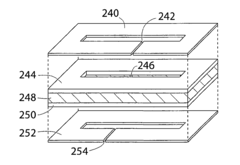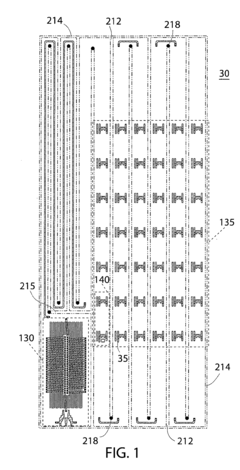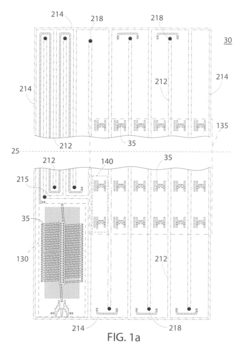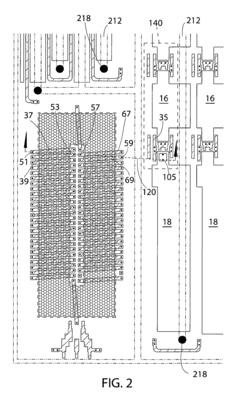PVDF in Flexible Circuit Design: Reducing Material Complexity
PVDF in Flexible Circuits: Background and Objectives
Polyvinylidene fluoride (PVDF) has emerged as a promising material in the realm of flexible circuit design, offering unique properties that address the growing demand for lightweight, durable, and adaptable electronic components. The evolution of PVDF in this field can be traced back to its initial discovery in 1948 by Kawai, who first observed its piezoelectric properties. Since then, PVDF has undergone significant development, transitioning from a novel polymer to a key player in advanced electronic applications.
The technological trajectory of PVDF in flexible circuits has been driven by the increasing need for miniaturization and flexibility in electronic devices. As consumer electronics, wearable technology, and IoT devices have proliferated, the limitations of traditional rigid circuit boards have become more apparent. PVDF's unique combination of flexibility, chemical resistance, and electrical properties has positioned it as a viable solution to these challenges.
In recent years, the focus on PVDF in flexible circuit design has intensified, with researchers and industry leaders exploring its potential to reduce material complexity. This objective aligns with the broader trend in electronics manufacturing towards simplification and cost-effectiveness without compromising performance. The ability of PVDF to serve multiple functions – as a substrate, dielectric, and even as an active component in certain applications – presents an opportunity to streamline the manufacturing process and reduce the number of materials required in flexible circuit production.
The current technological landscape sees PVDF being investigated for its potential to replace multiple layers in flexible circuits. Its piezoelectric properties are being harnessed for sensing and actuation applications, while its dielectric characteristics make it suitable for insulation and capacitive elements. Furthermore, ongoing research is exploring PVDF's potential in energy harvesting and storage within flexible circuits, which could lead to self-powered flexible electronic systems.
As we look towards the future, the technological goals for PVDF in flexible circuit design are multifaceted. Researchers aim to enhance PVDF's electrical and mechanical properties through various means, including nanocomposite formulations and novel processing techniques. There is also a push to develop PVDF-based flexible circuits that can withstand extreme conditions, expanding their applicability in aerospace, automotive, and medical industries.
The overarching objective in this field is to leverage PVDF's unique properties to create flexible circuits that are not only simpler in terms of material composition but also more robust, efficient, and versatile. This involves overcoming challenges such as improving adhesion to other materials, enhancing its barrier properties, and developing more efficient manufacturing processes that can scale for mass production.
Market Analysis for PVDF-based Flexible Circuits
The market for PVDF-based flexible circuits is experiencing significant growth, driven by the increasing demand for lightweight, durable, and high-performance electronic components across various industries. The global flexible circuit market is projected to reach $27 billion by 2025, with PVDF-based solutions expected to capture a substantial share due to their unique properties and versatility.
The automotive sector represents a key market for PVDF-based flexible circuits, particularly in electric and hybrid vehicles. These circuits are essential for battery management systems, sensor networks, and advanced driver assistance systems (ADAS). As the automotive industry continues its shift towards electrification and autonomous driving, the demand for PVDF-based flexible circuits is expected to surge.
Consumer electronics is another major market driver, with smartphones, wearables, and IoT devices requiring compact and flexible circuit solutions. PVDF's excellent mechanical properties and resistance to environmental factors make it an ideal choice for these applications. The growing trend of foldable and rollable displays further amplifies the need for PVDF-based flexible circuits in this sector.
In the aerospace and defense industries, PVDF-based flexible circuits are gaining traction due to their reliability in harsh environments and ability to withstand extreme temperatures and vibrations. These circuits are used in avionics, satellite communications, and military equipment, where performance and durability are critical.
The medical device industry is also adopting PVDF-based flexible circuits for applications such as implantable devices, wearable health monitors, and diagnostic equipment. The biocompatibility and flexibility of PVDF make it suitable for these sensitive applications, driving market growth in the healthcare sector.
Geographically, Asia-Pacific is expected to dominate the PVDF-based flexible circuit market, with China, Japan, and South Korea leading in production and consumption. North America and Europe follow closely, driven by technological advancements and high adoption rates in automotive and aerospace industries.
The market is characterized by intense competition among key players, including major electronics manufacturers and specialized flexible circuit producers. These companies are investing heavily in research and development to improve PVDF formulations and manufacturing processes, aiming to reduce costs and enhance performance.
Despite the positive outlook, challenges such as high initial costs and complex manufacturing processes may hinder market growth. However, ongoing technological advancements and increasing awareness of PVDF's benefits are expected to mitigate these challenges over time.
Current Challenges in PVDF Flexible Circuit Design
The integration of Polyvinylidene Fluoride (PVDF) in flexible circuit design presents several significant challenges that researchers and engineers are currently grappling with. One of the primary issues is the inherent complexity of PVDF as a material. While PVDF offers excellent properties such as flexibility, chemical resistance, and piezoelectric characteristics, its complex molecular structure makes it difficult to process and incorporate into traditional circuit manufacturing techniques.
The high melting point of PVDF, typically around 177°C, poses challenges in terms of thermal management during the circuit fabrication process. This high temperature requirement can potentially damage other components or substrates used in flexible circuits, limiting the range of materials that can be combined with PVDF. Additionally, the thermal expansion coefficient of PVDF differs from that of many common circuit materials, which can lead to stress and potential delamination in multi-layer structures.
Another significant challenge lies in achieving consistent and uniform thin film deposition of PVDF. The piezoelectric properties of PVDF, which are crucial for many applications, are highly dependent on the crystalline structure of the polymer. Controlling the crystallization process and ensuring a high degree of β-phase formation, which is responsible for the piezoelectric effect, remains a complex task in large-scale manufacturing.
The adhesion of PVDF to other materials used in flexible circuits, such as conductive traces and substrates, presents another hurdle. Poor adhesion can lead to delamination and failure of the circuit under mechanical stress or environmental conditions. Developing reliable bonding techniques that maintain the flexibility of the overall structure while ensuring strong interfacial adhesion is an ongoing area of research.
Furthermore, the electrical properties of PVDF, particularly its high dielectric constant, can introduce parasitic capacitance in circuit designs. This can affect signal integrity and limit the high-frequency performance of flexible circuits incorporating PVDF. Balancing the beneficial properties of PVDF with its potential impact on circuit performance requires careful design considerations and potentially new circuit topologies.
The long-term stability and reliability of PVDF in flexible circuit applications also remain areas of concern. Environmental factors such as humidity, temperature fluctuations, and UV exposure can potentially degrade the polymer over time, affecting both its mechanical and electrical properties. Developing effective encapsulation methods and understanding the aging mechanisms of PVDF in flexible circuit configurations are crucial for ensuring the longevity of devices.
Lastly, the integration of PVDF with other emerging flexible electronics materials and technologies, such as organic semiconductors or printed electronics, presents compatibility challenges. Aligning the processing requirements and performance characteristics of PVDF with these diverse materials and fabrication techniques requires innovative approaches and potentially new hybrid manufacturing processes.
Existing Solutions for PVDF Material Complexity Reduction
01 PVDF composite materials
PVDF can be combined with other materials to create composite materials with enhanced properties. These composites often involve blending PVDF with nanoparticles, fibers, or other polymers to improve mechanical strength, thermal stability, or electrical properties. The resulting materials can have applications in various industries, including electronics, aerospace, and energy storage.- PVDF composite materials: PVDF is often combined with other materials to create composite materials with enhanced properties. These composites can improve mechanical strength, thermal stability, or electrical conductivity. The addition of nanoparticles, fibers, or other polymers to PVDF can result in materials with unique characteristics suitable for various applications.
- PVDF membrane fabrication: The complexity of PVDF material is evident in membrane fabrication processes. Various techniques such as phase inversion, electrospinning, and stretching are employed to create PVDF membranes with specific pore sizes, structures, and surface properties. These membranes find applications in filtration, separation, and energy storage devices.
- PVDF in energy storage applications: PVDF's unique properties make it suitable for energy storage applications. Its high dielectric constant and good mechanical properties allow it to be used in capacitors, batteries, and piezoelectric devices. The material's complexity is evident in the various modifications and processing techniques used to optimize its performance in these applications.
- PVDF surface modification: Surface modification of PVDF is a complex process used to alter its properties for specific applications. Techniques such as plasma treatment, chemical grafting, and coating are employed to modify surface energy, hydrophobicity, or biocompatibility. These modifications expand the range of applications for PVDF materials.
- PVDF crystallization and phase behavior: The complexity of PVDF is particularly evident in its crystallization behavior and multiple crystalline phases. The material can exist in several polymorphs (α, β, γ, δ), each with distinct properties. Controlling the crystallization process and inducing specific phases are crucial for tailoring PVDF properties for various applications, adding to the material's complexity.
02 PVDF membrane fabrication
The complexity of PVDF material is evident in the various methods used to fabricate PVDF membranes. These methods may include phase inversion, electrospinning, or stretching techniques. The fabrication process can significantly affect the membrane's porosity, pore size distribution, and overall performance, making it crucial for applications such as water treatment and gas separation.Expand Specific Solutions03 PVDF in energy storage applications
PVDF's unique properties make it suitable for energy storage applications, particularly in lithium-ion batteries and supercapacitors. The material's complexity is demonstrated in its use as a binder for electrode materials, separator membranes, or as a component in solid electrolytes. Researchers are exploring ways to modify PVDF to enhance its performance in these applications.Expand Specific Solutions04 Surface modification of PVDF
The surface of PVDF can be modified to alter its properties and expand its applications. Techniques such as plasma treatment, chemical grafting, or coating with functional layers can change the material's hydrophobicity, biocompatibility, or chemical resistance. These modifications add to the complexity of PVDF material science and enable its use in diverse fields like biomedical engineering and protective coatings.Expand Specific Solutions05 PVDF copolymers and blends
The complexity of PVDF material extends to its copolymers and blends with other polymers. By incorporating different monomers or blending PVDF with other polymers, researchers can tailor the material's properties such as piezoelectricity, ferroelectricity, or processability. These modified forms of PVDF find applications in sensors, actuators, and flexible electronics.Expand Specific Solutions
Key Players in PVDF and Flexible Circuit Industry
The PVDF market in flexible circuit design is in a growth phase, driven by increasing demand for lightweight and durable electronic components. The market size is expanding, with a projected CAGR of 7.5% through 2026. Technologically, PVDF applications are advancing rapidly, with companies like Arkema, Inc., 3M Innovative Properties Co., and DuPont de Nemours, Inc. leading innovation. These firms are developing high-performance PVDF formulations to reduce material complexity in flexible circuits. Academic institutions such as Nanjing University of Aeronautics & Astronautics and Shenzhen University are contributing to research, while manufacturers like Samsung Display Co., Ltd. and Taiwan Semiconductor Manufacturing Co., Ltd. are integrating PVDF into cutting-edge flexible circuit designs, indicating a maturing technology landscape.
Arkema, Inc.
3M Innovative Properties Co.
Core Innovations in PVDF Flexible Circuit Design
- The use of clear vinyl stickers, conventional decorative foil, and UV reflective sticker glue replaces costly masking materials and collimated UV laser systems, allowing for a simpler and less expensive method to create high-precision FPCBs by ensuring tight adherence and minimizing light exposure between layers, eliminating the need for vacuum chambers and collimated light sources.
- A method is developed to enhance circuit flexibility by removing material from non-conductive layers, creating openings for component attachment and stress relief, and embedding electronic devices within a flexible substrate using wire bonding or solder attachment, allowing for automated manufacturing and reduced material usage.
Environmental Impact of PVDF in Flexible Electronics
The environmental impact of PVDF (Polyvinylidene fluoride) in flexible electronics is a critical consideration as the industry moves towards more sustainable practices. PVDF, while offering excellent properties for flexible circuit design, presents several environmental challenges throughout its lifecycle.
During the production phase, PVDF manufacturing involves the use of fluorine-based compounds, which can contribute to greenhouse gas emissions if not properly managed. The synthesis process often requires energy-intensive methods, leading to a higher carbon footprint compared to some alternative materials. Additionally, the production of PVDF monomers may involve the use of potentially harmful solvents, raising concerns about air and water pollution if strict environmental controls are not in place.
In the application stage, PVDF's durability and chemical resistance, while beneficial for product longevity, pose challenges for end-of-life management. The material's resistance to degradation means that PVDF-based flexible electronics may persist in the environment for extended periods if not properly disposed of or recycled. This persistence can contribute to long-term environmental accumulation and potential ecosystem disruption.
Recycling PVDF from flexible electronics presents technical difficulties due to its integration with other materials in complex layered structures. The separation process often requires specialized techniques, which may not be widely available in current recycling facilities. This limitation can lead to increased landfill disposal or incineration of PVDF-containing electronic waste, both of which have negative environmental implications.
When incinerated, PVDF can release hydrogen fluoride and other potentially toxic compounds, necessitating advanced emission control systems to mitigate air pollution risks. In landfills, while PVDF itself is relatively inert, there are concerns about the long-term leaching of additives or degradation products into soil and groundwater.
However, it's important to note that the environmental impact of PVDF in flexible electronics is not entirely negative. The material's durability and resistance to harsh conditions can lead to longer-lasting products, potentially reducing the overall electronic waste generated over time. Furthermore, ongoing research is exploring bio-based alternatives and improved recycling technologies for PVDF, which could significantly mitigate its environmental footprint in the future.
As the electronics industry continues to prioritize sustainability, there is a growing focus on developing eco-friendly alternatives to PVDF or improving its environmental profile. This includes research into bio-derived fluoropolymers, enhanced recycling processes, and the development of PVDF formulations with reduced environmental persistence. These efforts aim to balance the material's excellent performance characteristics with improved environmental sustainability in flexible circuit design.
Cost-Benefit Analysis of PVDF in Flexible Circuits
The implementation of PVDF (Polyvinylidene Fluoride) in flexible circuit design presents a compelling case for cost-benefit analysis. This advanced material offers unique properties that can significantly enhance the performance and durability of flexible circuits, potentially justifying its higher initial cost.
From a cost perspective, PVDF is generally more expensive than traditional materials used in flexible circuits, such as polyimide or PET. The raw material cost of PVDF can be up to 30-50% higher, depending on market conditions and supply chain factors. Additionally, the processing of PVDF may require specialized equipment and techniques, potentially increasing manufacturing costs.
However, the benefits of PVDF in flexible circuit applications are substantial. Its excellent chemical resistance and thermal stability contribute to extended product lifespans, reducing long-term replacement and maintenance costs. PVDF's superior mechanical properties, including high flexibility and fatigue resistance, allow for the design of more durable and reliable circuits that can withstand repeated bending and flexing without failure.
The piezoelectric properties of PVDF open up new possibilities for integrated sensing and energy harvesting within flexible circuits. This multifunctionality can lead to cost savings in overall system design by reducing the need for separate components. Furthermore, PVDF's low dielectric constant and dissipation factor contribute to improved signal integrity and reduced signal loss, potentially lowering power consumption and extending battery life in portable devices.
When considering environmental factors, PVDF's recyclability and low toxicity align with growing sustainability requirements, potentially reducing end-of-life disposal costs and environmental impact. This aspect can be particularly valuable in industries facing stringent environmental regulations.
The adoption of PVDF in flexible circuits may also lead to indirect cost benefits. Its unique properties enable the design of thinner, lighter, and more compact devices, potentially reducing material usage in other parts of the product and lowering shipping costs. Additionally, the enhanced reliability of PVDF-based circuits can decrease warranty claims and improve customer satisfaction, contributing to long-term brand value and market share.
In conclusion, while the upfront costs of incorporating PVDF into flexible circuit design are higher, the long-term benefits in terms of performance, durability, and multifunctionality present a strong case for its adoption. As production scales and processing techniques improve, the cost-benefit ratio is likely to become even more favorable, making PVDF an increasingly attractive option for advanced flexible circuit applications.



